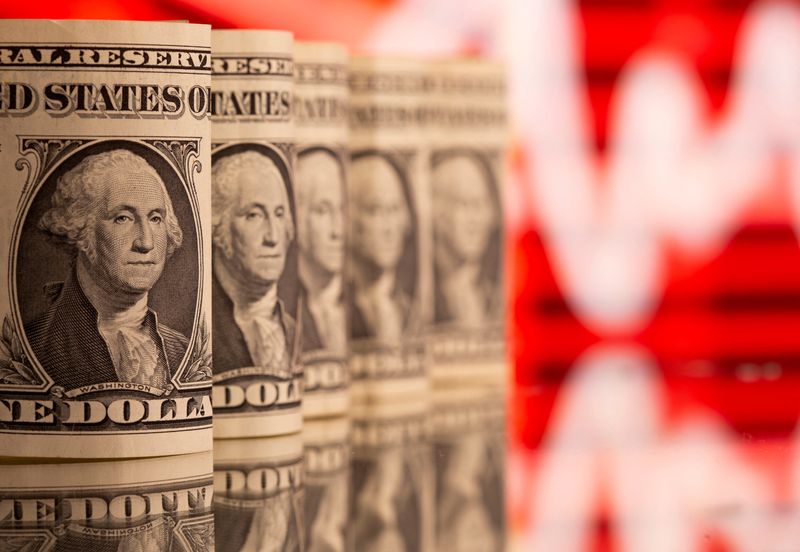Forex
Dollar falls with US rates seen at peak, pound firm after BoE


© Reuters. FILE PHOTO: U.S. one dollar banknotes are seen in front of displayed stock graph in this illustration taken, February 8, 2021. REUTERS/Dado Ruvic/Illustration/File Photo
By Samuel Indyk
LONDON (Reuters) – The dollar fell broadly on Thursday as investors grew more convinced that a peak in U.S. interest rates has been reached after the Federal Reserve kept them on hold the previous day.
Sterling held firm after the Bank of England kept rates at a 15-year high and stressed that it did not expect to start cutting them any time soon.
Fed Chair Jerome Powell left the door open to another hike, but with the funds rate target ceiling at a 22-year high of 5.5% he said the risks of doing too much or too little were now balanced.
Markets took that as a green light to stick with a sub 20% chance that rates will rise in December. Ten-year Treasury yields are down 24 basis points from Wednesday’s highs, equities rallied and risk-sensitive currencies bounced.
“Powell had the opportunity to raise a bit of concern with the latest rise in short-term inflation expectations but he chose not to do that,” said Kristoffer Lomholt, head of FX research at Danske Bank.
“There was a possibility of sending a much more hawkish signal but he chose not to and I think that’s what markets are reacting to.”
The , which measures the greenback against six other major currencies, was 0.5% lower at 105.94 and down by around 1% from Wednesday’s high.
The pound rose as much as 0.6% against the dollar to $1.2222, its highest level in 1-1/2 weeks after the BoE voted 6-3 to hold rates steady at a 15-year peak of 5.25%, while ruling out rate cuts any time soon.
“The question going forward is how long this standstill will last for – with financial markets expecting it to be a considerable period of smooth sailing,” said Jeremy Batstone-Carr, strategist at Raymond James.
“The door for future rate hikes still sits ajar, and the MPC will likely remain vigilant for further fluctuations and risks in the months ahead.”
Norway’s central bank also left its benchmark rate unchanged as widely expected but said it would likely raise borrowing costs next month unless inflation showed a continued decline.
The Norwegian crown strengthened to 11.176 per dollar but was down to 11.899 against the broadly stronger euro.
The euro rose more than 0.8% against the dollar to $1.0654, the Swiss franc was higher for a second day and the yen was helped further from a one-year low to 150.07 per dollar.
The yen has been struggling for traction, even as the Bank of Japan on Tuesday made another relaxation of its yield curve control policy.
A fall to a one-year low of 151.74 per dollar and 15-year low of 160.83 per euro after the BoJ’s announcement had traders on watch for possible intervention to prop up the currency.
“The important thing is the tempo of the fall,” Danske Bank’s Lomholt said. “That’s when we have seen them verbally come out and talk against the appreciation.”
Kazuo Ueda, the central bank’s governor, will continue to dismantle its ultra-loose monetary policy and look to exit the decade-long accommodative regime sometime next year, sources told Reuters.
The Australian dollar, which jumped 0.9% on Wednesday, was up another 0.7% on Thursday to touch a near five-week high of $0.6446. The New Zealand dollar rose 1% to a two-week peak of $0.5910.
, sometimes traded as a proxy for risk-taking, broke above $35,000 to hit its highest level since May 2022.

 Forex3 years ago
Forex3 years agoForex Today: the dollar is gaining strength amid gloomy sentiment at the start of the Fed’s week

 Forex3 years ago
Forex3 years agoUnbiased review of Pocket Option broker

 Forex3 years ago
Forex3 years agoDollar to pound sterling exchange rate today: Pound plummeted to its lowest since 1985

 Forex3 years ago
Forex3 years agoHow is the Australian dollar doing today?

 Cryptocurrency3 years ago
Cryptocurrency3 years agoWhat happened in the crypto market – current events today

 World3 years ago
World3 years agoWhy are modern video games an art form?

 Commodities3 years ago
Commodities3 years agoCopper continues to fall in price on expectations of lower demand in China

 Economy3 years ago
Economy3 years agoCrude oil tankers double in price due to EU anti-Russian sanctions























